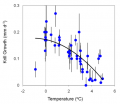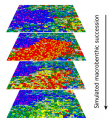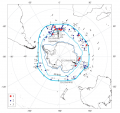Search results
Create the page "Models" on this wiki! See also the search results found.
Page title matches

File:Figure 5.1 - Projected global annual CO2 emissions, 1990-2100, used to run models for the IPCC AR4.png (524 × 315 (105 KB)) - 15:31, 6 August 2014- :''This page is part of the topic [[Models of the physical and biological environment of the Antarctic]]'' ...past and present-day climates. Simulation of present day climates by these models provides a way of rigorously testing their ability to reproduce reality. Su13 KB (2,051 words) - 15:33, 6 August 2014
- :''This page is part of the topic [[Models of the physical and biological environment of the Antarctic]]'' ...tion of subglacial sediments. A recent overview of the status of Antarctic models is provided by Huybrechts (2004<ref name="Huybrechts, 2004">Huybrechts, P.33 KB (5,053 words) - 15:33, 6 August 2014
- ...iological studies. In this section we examine some of the major classes of models used in Antarctic studies. #[[Coupled atmosphere-ocean models]]2 KB (322 words) - 15:33, 6 August 2014
- :''This page is part of the topic [[Models of the physical and biological environment of the Antarctic]]'' ...omise between cost and physical realism. This is especially true for ocean models because the computational cost is always high, and can be hundreds of times37 KB (5,859 words) - 15:33, 6 August 2014
- :''This page is part of the topic [[Models of the physical and biological environment of the Antarctic]]'' ...e large amount of computer time needed by the complex atmosphere and ocean models, but also due to a lack of observations and knowledge of the cryospheric co5 KB (833 words) - 15:33, 6 August 2014
Page text matches

File:Figure 5.11 - Observations and model predictions of minimum September to October total column ozone.png Minimum total column ozone in September to October predicted by various models, plus observations from the National Institute of Water and Atmosphere Rese(543 × 488 (113 KB)) - 15:30, 6 August 2014
File:Figure 5.2 - Temperature trends for 1960-2000 for winter (JJA).png ...M. and Bracegirdle, T.J. 2007. An Antarctic assessment of IPCC AR4 coupled models, ''Geophys. Res. Lett.'', '''34''', L22505, doi:10.1029/2007GL031648.</ref>(554 × 288 (145 KB)) - 15:30, 6 August 2014
File:Figure 5.19 - Projected sea-level rise for the Twenty First Century.png ...or all greenhouse gas scenarios, the light shading is the envelope for all models and all scenarios and the outer lines include an allowance for an additiona(532 × 353 (134 KB)) - 15:31, 6 August 2014
File:Figure 5.5 - Mean regression of the leading EOF of ensemble mean SH sea level pressure.png ...century Intergovernmental Panel on Climate Change Fourth Assessment Report models, J. Geophys. Res., 111, doi:10.1029/2005JD006323.</ref>). From IPCC (2007<r(542 × 244 (146 KB)) - 15:31, 6 August 2014
File:Figure 5.14 - Zonal mean difference between observed and simulated temperature and salinity, 1981-2000.png ...ean Atlas (2001, http://www.nodc.noaa.gov/OC5/WOA01/pr_woa01.html). The 19 models for which sufficient data for the 20C3M runs was available are CCCMA CGCM3.(514 × 597 (107 KB)) - 15:31, 6 August 2014
File:Figure 5.20 - Regional sea level rise projections in 2100 under SRESA1B relative to the global mean.png Regional Sea level rise projections for 15 IPCC AR4 models for the SRESA1B scenario at 2100 relative to the global mean, following the(459 × 675 (274 KB)) - 15:31, 6 August 2014
File:Figure 5.23 - Primary productivity changes for 2040-2060 in six coupled climate carbon models.png ...alkowski, P.G. 1997. A consumers guide to phytoplankton primary production models, ''Limnol. Oceanogr.'', '''47''', 1479-1491.</ref>), and changes were asses(278 × 590 (57 KB)) - 15:31, 6 August 2014
File:Figure 2.31 - Simulated 20th century Weddell Gyre strength in 16 AR4 climate models.png ...ted decadal means of Weddell Gyre strengths by 16 IPCC AR4 coupled climate models during the 20th century (IPCC, 2007<ref name="IPCC, 2007">IPCC 2007. Climat(553 × 790 (106 KB)) - 15:31, 6 August 2014
File:Figure 5.9 - 21st century change in the annual cycle of Antarctic precipitation under the A1B scenario.png ...mong the 21 models, while the light grey area shows the total range of the models.(437 × 453 (50 KB)) - 15:31, 6 August 2014
File:Figure 4.51 - Daily growth rates of krill in the Scotia Sea.png ...atural growth rates of Antractic krill (Euphausia superba): II: Predictive models based on food, temperature, body length, sex, and maturity stage, ''Limnolo(419 × 363 (28 KB)) - 15:31, 6 August 2014
File:Figure 1.10 - Major currents south of 20S.png ...2008. Density-driven Southern Hemisphere subpolar gyres in coupled climate models, Geophysical Research Letters, 35(14) 5, pp. 10.1029/2008GL034344.</ref>),(601 × 589 (308 KB)) - 15:31, 6 August 2014
File:Figure 5.13 - Zonal mean total inorganic chlorine in October at 50hPa and 80S predicted by models.png ...chlorine (ppbv) in October at 50 hPa (20-25 km) and 80°S predicted by models: (a) total, (b) difference from 1980. Open black diamonds in (a) show estim(487 × 319 (86 KB)) - 15:31, 6 August 2014
File:Figure 2.32 - Simulated 20th century Antarctic precipitation in 16 AR4 climate models.png ...ation averaged over the Antarctic continent by 16 IPCC AR4 coupled climate models during the 20th century.(553 × 802 (98 KB)) - 15:31, 6 August 2014
File:Figure 2.37 - Simulation of a benthic succession.png ...uency due to enhanced deglaciation in Antarctica. Thus, spatially explicit models can be a useful tool predicting biodiversity changes under these different(369 × 411 (227 KB)) - 15:31, 6 August 2014
File:Figure 3.17 - Sea ice distribution at the Southern Ocean EPILOG-LGM time slice.png ...in percent derived with Modern Analog Techniques and Generalized Additive Models. Signature legend: (1) concomitant occurrence of cold-water indicator diato(552 × 520 (145 KB)) - 15:31, 6 August 2014- ...or all greenhouse gas scenarios, the light shading is the envelope for all models and all scenarios and the outer lines include an allowance for an additiona ...on from Greenland and Antarctica. However, as mentioned earlier, ice sheet models are incomplete and do not allow for a rapid dynamic response of the ice she16 KB (2,491 words) - 13:16, 22 August 2014
- ...ace air temperature it is possible to use the projections from the various models to derive various estimates of how temperature may change over land and oce The atmospheric component of the next generation of climate models must have interactive chemistry if we are to obtain meaningful projections5 KB (788 words) - 16:49, 6 August 2014
- .... The ice core data are also crucial in benchmarking climate and ice sheet models against observations. The longest ice core records date back over 800 ka (J17 KB (2,554 words) - 16:45, 6 August 2014
- ##[[Models of the physical and biological environment of the Antarctic]]4 KB (504 words) - 17:51, 21 August 2014
- ...et during and after the LGM and its contribution to global sea level. Most models predict the Antarctic Ice Sheet to have contributed c. 20 m to global sea l .../ref>), but the limited distribution of Antarctic RSL sites means that the models are still not as well constrained as for other continents.21 KB (3,294 words) - 15:33, 6 August 2014
- ...be used for predictions of the future. Instead, coupled Chemistry-Climate Models are used. Those whose results are described below vary in their skill in re '''Table 5.1''' Models whose results appear in Figures 5.11, 5.12 and 5.13; * bromine chemistry no27 KB (4,305 words) - 16:22, 6 August 2014
- The availability of gridded data from numerical weather prediction (NWP) models and reanalyses allows entirely automated methods to be used that can provid54 KB (8,177 words) - 13:38, 22 August 2014
- ...ulti-model study, ''Ocean Sci.'', '''1''', 81-95.</ref>), although in some models a peak at around 7 years is observed (Marshall et al., 2007<ref name="Marsh ...Twentieth century simulation of the Southern Hemisphere climate in coupled models. Part 1: Large scale circulation variability, ''Clim. Dyn.'', '''26''', 21729 KB (4,462 words) - 17:11, 22 August 2014
- ...40-year trends similar to those observed are reproduced in global climate models forced by a combination of ozone depletion, and increasing greenhouse gas c ...and of the consequences for inland ice sheet flow are needed to test such models. To attribute the glaciological changes in the Amundsen Sea sector to a par13 KB (1,943 words) - 15:33, 6 August 2014
- :''This page is part of the topic [[Models of the physical and biological environment of the Antarctic]]'' ...rona antarctica (Myctophidae, Pisces) in Kerguelen by generalized additive models and geographic information systems, ''Polar Biol.'', '''30''', 951-959.</re8 KB (1,225 words) - 15:33, 6 August 2014
- ...ntarctic surface mass balance and systematic biases in general circulation models, ''J. Geophys. Res.'', '''106''', 20653-20664.</ref>), van Lipzig et al. (2 ...meterizations of polar cloud microphysics and precipitation in atmospheric models (Guo et al., 2003<ref name="Guo et al, 2003">Guo, Z., Bromwich, D.H. and Ca20 KB (3,125 words) - 15:33, 6 August 2014
- ...is debated. In order to improve the incorporation of sea ice into computer models of future climate change it will be essential to use proxy records to repre24 KB (3,785 words) - 17:17, 22 August 2014
- ...radically revise their view of ice sheet sensitivity to climate. Existing models, based primarily on earlier views of the essential governing dynamics of ic ...et, Science, 320, No. 5877, 781-783.</ref>). It must be borne in mind that models disagree over many other details of atmospheric climate change in Antarctic26 KB (4,124 words) - 14:04, 22 August 2014
- ...at have survived through glacial cycles also challenges existing ice sheet models where most of the available habitats are covered at the LGM.7 KB (1,082 words) - 15:33, 6 August 2014
- :''This page is part of the topic [[Models of the physical and biological environment of the Antarctic]]'' ...past and present-day climates. Simulation of present day climates by these models provides a way of rigorously testing their ability to reproduce reality. Su13 KB (2,051 words) - 15:33, 6 August 2014
- ...elf. While the Antarctic Peninsula Ice Sheet (APIS) has, according to some models, been a relatively minor (1-2 m) contributor to post-LGM sea level rise, it22 KB (3,430 words) - 13:03, 22 August 2014
- ...004. Southern Ocean sea ice and its wider linkages: insights revealed from models and observations, ''Antarctic Science'', '''16''', 387-400.</ref>). Food we15 KB (2,381 words) - 15:33, 6 August 2014
- ...ched in 2009. Ocean salinity observations will be important to studies and models of the circulation of the Southern Ocean and the role of sea ice. These obs ...hese data are essential for understanding ocean processes and as inputs to models for forecasting future change.7 KB (1,040 words) - 16:16, 22 August 2014
- ...sea ice cover, sea level rise and rising terrestrial carbon storage. Other models have identified the importance of on and off states of the southern overtur35 KB (5,415 words) - 15:33, 6 August 2014
- ...in percent derived with Modern Analog Techniques and Generalized Additive Models. Signature legend: (1) concomitant occurrence of cold-water indicator diato17 KB (2,705 words) - 17:43, 22 August 2014
- :''This page is part of the topic [[Models of the physical and biological environment of the Antarctic]]'' ...tion of subglacial sediments. A recent overview of the status of Antarctic models is provided by Huybrechts (2004<ref name="Huybrechts, 2004">Huybrechts, P.33 KB (5,053 words) - 15:33, 6 August 2014
- ...thermal ectotherms. In: Davison W, Williams CW (Eds) Antarctic Ecosystems: Models for a Wider Understanding, Caxton Press, Christchurch, New Zealand, 109-122 ...al growth rates of Antractic krill (''Euphausia superba''): II: Predictive models based on food, temperature, body length, sex, and maturity stage, ''Limnolo25 KB (3,817 words) - 15:33, 6 August 2014
- ...s their consequences for the biosphere, and shows how the latest numerical models project changes into the future, taking into account human interference in ..., which is sensitive to changes in atmospheric and oceanic conditions. The models can be weighted according to their skill in simulating modern conditions.</48 KB (7,673 words) - 18:27, 22 August 2014
- ...DRILLing (ANDRILL) project geological records, a feature also simulated by models (Pollard and DeConto, 2009<ref name="Pollard and DeConto, 2009">Pollard, D. ...) points to significant loss of Greenland and Antarctic ice. While climate models are able to capture the patterns of the orbital-driven warming of the Arcti142 KB (22,142 words) - 16:25, 6 August 2014
- ...pointed out by Milne (2009<ref name="Milne, 2009">Milne, G.A. 2009. Using models to inform the field community: Far-field sea level data applications, PAGES8 KB (1,342 words) - 15:33, 6 August 2014
- ...es. In: Davison W, Howard-Williams C, Broady P (eds) Antarctic Ecosystems: Models for Wider Ecological Understanding. Caxton Press, Christchurch, 315-318.</r ...overall transport of POPs to remote regions is accelerated with respect to models treating air and water separately (Beyer and Matthies, 2001<ref name="Beyer38 KB (5,770 words) - 15:33, 6 August 2014
- ...fferent scenarios both experimentally and computationally to inform future models and enhance our understanding of Southern Ocean microbial ecology.2 KB (305 words) - 15:33, 6 August 2014
- ...egions, and hence the forecasts made by Numerical Weather Prediction (NWP) models. Today, regions such as the Southern Ocean, previously a data void, are fil ...s, ''Ann. Glaciol'', '''20''', 242-248.</ref>). Satellites and atmospheric models provide some information about snow accumulation away from traverse routes,59 KB (9,046 words) - 15:33, 6 August 2014
- ...els throw up contradictions that cannot be solved until new generations of models or observations become available. ...including both general circulation models (GCM) and simplified theoretical models, have been carried out in an effort to improve our understanding of the bas8 KB (1,343 words) - 15:33, 6 August 2014
- ...iological studies. In this section we examine some of the major classes of models used in Antarctic studies. #[[Coupled atmosphere-ocean models]]2 KB (322 words) - 15:33, 6 August 2014
- ...rror. Nevertheless, as shown above, extreme temperatures are not expected; models suggest a 0.5º to 1.0ºC rise in the temperature of Southern Ocean ...do suggest the fauna is highly sensitive to acute warming. Current climate models suggest that acute warming is unlikely, as are average rises of more than 154 KB (8,443 words) - 17:49, 22 August 2014
- In this chapter we consider the various types of data and models that are available to investigate climatic and environmental change in the Mathematical models have been utilized increasingly in Antarctic research. Initially their appl2 KB (307 words) - 16:44, 6 August 2014
- ...age appears to be another important driving factor of the ACC transport in models. The errors in the simulation of this density gradient, partly due to probl ...s. The gyre strengths and structures show a great range across the various models. The link between the gyre strengths and wind stress curls is weak, indicat33 KB (5,321 words) - 15:57, 22 August 2014
- :''This page is part of the topic [[Models of the physical and biological environment of the Antarctic]]'' ...omise between cost and physical realism. This is especially true for ocean models because the computational cost is always high, and can be hundreds of times37 KB (5,859 words) - 15:33, 6 August 2014
- ...ty analyses and models, as well as mechanistic studies and mechanism-based models. This approach demands an intensive coordination, not only of ongoing, but ...d to predict transport of propagules into (and out of) the Antarctic. Such models can also be used to elucidate advective processes in the Southern Ocean and25 KB (3,663 words) - 15:33, 6 August 2014